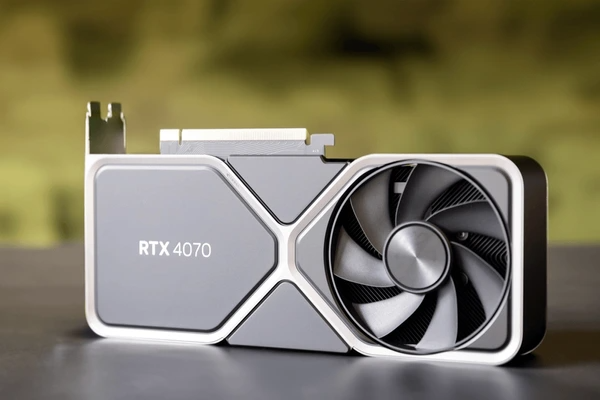
When it comes to high-performance gaming and creative workloads, NVIDIA’s RTX 40-series graphics cards stand out as some of the most powerful options available. Among them, the RTX 4070 vs. RTX 4080 offer impressive performance, but they cater to slightly different audiences and use cases. In this article, we will dive deep into the key differences, real-world performance, pricing, and ideal use cases for each GPU, helping you decide which one best suits your needs.
RTX 4070 Overview
The RTX 4070 is positioned as a high-performance, mid-tier GPU, designed for gamers and creators who want solid performance at a more affordable price than the high-end options like the RTX 4080 or RTX 4090. Despite its lower price, it delivers outstanding performance in 1440p and 4K gaming, alongside great ray tracing capabilities.

Key Features of the RTX 4070
- Architecture: Built on the Ada Lovelace architecture, delivering significant performance improvements over its predecessors.
- CUDA Cores: 5,888 CUDA cores, which provide excellent parallel computing power for gaming and creative applications.
- Memory: 12 GB of GDDR6X VRAM at a 192-bit memory interface.
- Ray Tracing: Advanced ray tracing and DLSS 3.0 support, providing enhanced graphical realism in supported games.
- Power Consumption: With a TDP of 200W, it strikes a balance between power efficiency and performance.
Performance of the RTX 4070
In gaming, the RTX 4070 excels at 1440p resolution and performs decently in 4K. It’s a great choice for those who prioritize frame rates over ultra settings in demanding titles. With features like DLSS 3.0 and ray tracing, it provides gamers with enhanced visual fidelity while maintaining smooth gameplay even in graphically intense scenarios.
To better understand the performance of the RTX 4070, Eureka Technical Q&A provides in-depth comparisons and performance metrics, helping you evaluate key specs like frame rates, power efficiency, and value to make an informed purchasing decision.
Ideal Use Cases for the RTX 4070
- 1440p and 4K Gaming: Excellent performance at 1440p, capable of handling 4K gaming at medium to high settings.
- Content Creation: Suitable for video editing, 3D rendering, and other creative workloads at a relatively affordable price point.
- Budget-Conscious Enthusiasts: Perfect for gamers or creators who want high performance without breaking the bank.
RTX 4080 Overview
The RTX 4080, on the other hand, is a high-end graphics card designed for enthusiasts and professionals who demand the best performance in both gaming and content creation. With double the CUDA cores of the RTX 4070 and a larger memory bus, the RTX 4080 provides exceptional performance at 4K and beyond.
Key Features of the RTX 4080
- Architecture: Also built on the Ada Lovelace architecture, designed to deliver massive improvements in both ray tracing and AI-based rendering.
- CUDA Cores: 9,728 CUDA cores, offering a significant leap in parallel processing performance.
- Memory: 16 GB of GDDR6X VRAM at a 256-bit memory interface, providing ample bandwidth for high-resolution workloads.
- Ray Tracing: Advanced ray tracing capabilities with DLSS 3.0 for unmatched performance in supported games.
- Power Consumption: With a TDP of 320W, the RTX 4080 demands more power but delivers a corresponding performance boost.

Performance of the RTX 4080
The RTX 4080 is designed for ultra settings at 4K and even handles 8K gaming in many cases. Its massive increase in CUDA cores, memory bandwidth, and overall architectural improvements make it an excellent choice for high-end gaming, 3D rendering, AI development, and virtual production.
Ideal Use Cases for the RTX 4080
- 4K Gaming: Handles 4K gaming at ultra settings with ease, delivering smooth frame rates even in the most demanding titles.
- Professional Workloads: With more VRAM and power, it’s better suited for 3D modeling, AI workloads, video rendering, and other high-performance applications.
- Future-Proofing: The RTX 4080 is built to handle next-gen gaming and content creation workloads for the years to come.
Key Differences Between RTX 4070 and RTX 4080
| Feature | RTX 4070 | RTX 4080 |
|---|---|---|
| CUDA Cores | 5,888 | 9,728 |
| Memory | 12 GB GDDR6X | 16 GB GDDR6X |
| Ray Tracing | Yes (DLSS 3.0 support) | Yes (DLSS 3.0, advanced RT cores) |
| Power Consumption | 200W | 320W |
| Price | Lower cost (more budget-friendly) | Higher cost (premium performance) |
| Target Audience | Gamers, creators, budget-conscious | Enthusiasts, professionals, 4K+ gamers |
| Performance | Great for 1440p and 4K at medium/high settings | Ultra 4K gaming, content creation, and AI tasks |
Real-World Performance: 4070 vs. 4080
Gaming Benchmarks
- RTX 4070: In titles like Cyberpunk 2077 and Shadow of the Tomb Raider, the RTX 4070 performs well at 1440p with high settings. At 4K, it can handle the game with medium settings while delivering 60+ FPS.
- RTX 4080: On the other hand, the RTX 4080 can easily handle 4K gaming at ultra settings with high frame rates. It also delivers significant improvements in ray tracing performance, allowing for greater graphical fidelity without sacrificing frame rates.
Content Creation
- RTX 4070: For video editing and 3D rendering, the RTX 4070 performs well but may take a hit in extremely demanding tasks like high-resolution rendering or complex simulations. It can still handle most content creation tasks at a relatively quick pace, especially for 1080p and 1440p content.
- RTX 4080: With its additional memory and cores, the RTX 4080 is ideal for professional content creation, including 4K video editing, VFX rendering, and 3D modeling. It can handle complex projects much faster, making it a superior choice for professionals working on resource-heavy applications.
Which GPU Should You Choose: RTX 4070 vs. RTX 4080?
The choice between the RTX 4070 and RTX 4080 boils down to your specific use case and budget:
- Choose the RTX 4070 if:
- You’re primarily gaming at 1440p or 4K and want solid performance at a more affordable price.
- You’re a budget-conscious gamer or creator who doesn’t require the absolute highest-level performance.
- You need a mid-tier GPU that balances price and performance.
- Choose the RTX 4080 if:
- You’re looking for the best performance for 4K gaming, next-gen graphics, and future-proofing your system.
- You work with demanding creative applications like 3D rendering or AI tasks.
- You’re an enthusiast or professional willing to invest in premium performance.
Final Thoughts
Both the RTX 4070 and RTX 4080 offer excellent performance, but they cater to different segments. The RTX 4070 provides great performance for those who prioritize cost-effective gaming and content creation, while the RTX 4080 delivers unmatched power for those who demand the best, whether for high-end gaming, professional workflows, or future-proofing.
Before making your decision, consider your budget, performance requirements, and use cases to ensure you choose the right GPU for your needs.
FAQs
1. Is the RTX 4070 better for 4K gaming than the RTX 4080?
The RTX 4080 is far better for 4K gaming at ultra settings. The RTX 4070 performs well at medium settings for 4K but may struggle with ultra settings.
2. Can the RTX 4070 handle ray tracing well?
Yes, the RTX 4070 supports ray tracing and DLSS 3.0, providing a great experience at 1440p and 4K with ray tracing enabled.
3. Is the RTX 4080 worth the higher price?
If you want the best performance for 4K gaming and professional content creation, the RTX 4080 is worth the investment for its premium performance.
4. Can I use the RTX 4070 for professional creative tasks?
The RTX 4070 is suitable for most creative workflows at 1080p and 1440p but may not be as fast as the RTX 4080 for very demanding applications.
To get detailed scientific explanations of 4070 vs. 4080, try Patsnap Eureka.


